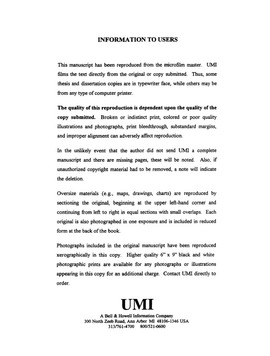| dc.contributor.advisor | Forgotson, James, | en_US |
| dc.contributor.author | Saxon, Christopher Paul. | en_US |
| dc.date.accessioned | 2013-08-16T12:30:05Z | |
| dc.date.available | 2013-08-16T12:30:05Z | |
| dc.date.issued | 1998 | en_US |
| dc.identifier.uri | https://hdl.handle.net/11244/5658 | |
| dc.description.abstract | Structural style shows significant variation along the mountain front. Two types of variation in style are present. The first is an abrupt variation, occurring where a compartmental fault offsets the mountain front and style shows significant variation across the compartmental fault or across a steep lateral ramp. The second is a gradational variation, occurring as the result of change in fold shape, plunge, gradual variation in elavation of lateral ramps, fault-to-fold interchanges, and progressive loss of slip along strike. | en_US |
| dc.description.abstract | Structural style is of horizontal compression along low-angle basement-involved thrusts. Structural style is determined by magnitude of basement folding during early-stages of deformation. Shortening was accomplished primarily along southwest-dipping thrusts, although significant northeast-dipping back thrusts are present. The major basement-cored uplifts form an en echelon arraignment which trend northwest-southeast, with primary vergence to the northeast. Basment thrusts lose slip laterally, terminating as fault-fold interchanges or against compartmental faults. Two end members of basement deformation exists, though in most areas deformation is a hybrid between end members. Mode I is similar to Berg's (1962) fold-thrust model. Foreland detachment structures, which form large intra-basinal folds, provide strong geometric evidence for syncline crowding and evidence folding prior to the development of the main mountain-flank fault. In mode II, initial folding is relatively minor. Deformation occurs primarily by faulting along a low-angle thrust whose shape may be modified by fault-bend folding. After leaving the basement, the fault typically travels in the Arbuckle Group as a flat or low-angle ramp. | en_US |
| dc.description.abstract | Pennsylvanian deformation in the Southern Oklahoma Foreland occurred as a basement-involved fold belt which resulted in intra-plate crustal shortening foreland of the Ouchita System. Deformation is characterized by northwest trending faults which dip at low- to moderate-angles to the southwest and northeast, is superimosed across a Precambrian-Cambrian grain of extension, and was part of regional Mississippian-Permian intra-plate crustal shortening. Deforamation occurred in two pulses: (1) the Wichita Orogeny, which occurred from Mississippian through Atokan, which uplifted the Amirillo-Wichita Mountains, and (2) the Arbuckle Orogeny, which occurred from Virgilian to early Wolfcampian and uplifted the Arbuckle Anticline. Deformation moved from southwest to northeast as a wave. | en_US |
| dc.format.extent | xix, 248 leaves, [14] folded leaves of plates : | en_US |
| dc.subject | Geology, Stratigraphic. | en_US |
| dc.subject | Geology, Structural Oklahoma. | en_US |
| dc.subject | Geology. | en_US |
| dc.title | Structural style of the Wichita and Arbuckle Orogenies, Southern Oklahoma. | en_US |
| dc.type | Thesis | en_US |
| dc.thesis.degree | Ph.D. | en_US |
| dc.thesis.degreeDiscipline | Conoco Phillips School of Geology and Geophysics | en_US |
| dc.note | Source: Dissertation Abstracts International, Volume: 59-07, Section: B, page: 3305. | en_US |
| dc.note | Chairperson: James Forgotson. | en_US |
| ou.identifier | (UMI)AAI9839792 | en_US |
| ou.group | Mewbourne College of Earth and Energy::Conoco Phillips School of Geology and Geophysics | |
